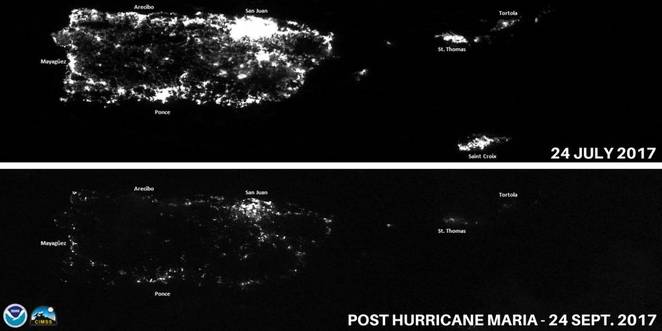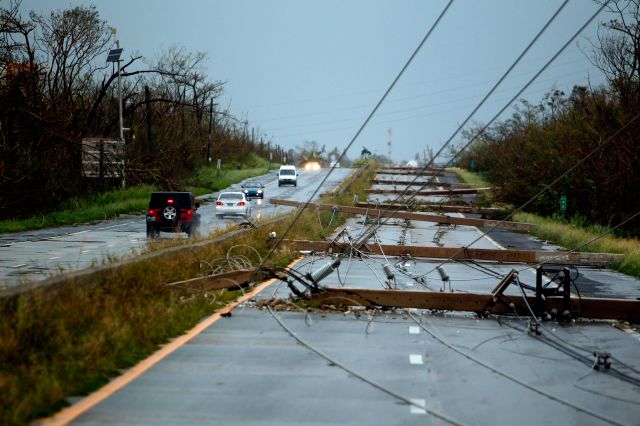
Puerto Rico’s utility sector has a very long and politicized history, and politics will play a big role in how the island territory will recover from the devastation of Hurricane Maria, a category 4 storm that hit the island on September 20, 2017. Puerto Rico, barely recovering from Hurricane Irma, was devastated by Maria, a storm so large and so direct that its eye alone literally covered the entire island. The storm destroyed more than three-fourths of the island’s power infrastructure, leaving Puerto Rico’s 3.5 million residents without power. Current estimates are that most of the island won’t get power from the central grid for months. This reality is catastrophic for residents, who are running out of generator fuel, food, and clean drinking water.
Even before the destruction, Puerto Rico’s power system was in trouble, with antiquated equipment and infrastructure, and $9 billion in debt. TIME magazine reports that half of the territory’s electricity came from imported oil, power outages were a frequent occurrence, and electricity prices were astronomical, second only to Hawaii’s.
Almost two weeks have passed since Maria, and Puerto Rico is still in a state of crisis. Non-urban areas are completely lacking in any infrastructure, and in cities, apartment-dwellers are living in unbearably hot buildings. Hospitals can’t keep medicines cold.
Otis Rolley, the 100 Resilient Cities regional director for North America, tells Wired magazine that the goal should be to “rebuild in a fundamentally different way so that the source is cleaner and the distribution is more reliable.”
Starting with purpose vs. more of the same
A key question, though, is what will this rebuilding look like? One possibility is that the island keeps the centralized status quo. But with the situation being untenable to begin with and the possibility of more extreme storms in the future, that plan is incredibly short-sighted and dangerous. The current crisis calls for a drastically different vision, and that vision is to build a brand-new system that is more resilient in the face of unknown future storms and uses.
The new system must also incorporate local energy resources (mainly solar and wind) that forego the unreliability and expense of shipping in fossil fuels. Those local resources can also start providing services immediately after a hurricane.
Microgrids, primarily powered by renewables, are inherently more reliable and resilient. They don’t rely on transmission lines going over mountain ridges. They use local power sources, so that even if there is damage to the transmission and distribution system, local communities have some power instead of being completely in the dark, as is now the case for the vast majority of Puerto Ricans.
Making the case for a distributed energy future in Puerto Rico
The obvious solution is a move to solar and wind microgrids with battery storage. Puerto Rico Governor Ricardo Rosselló is thinking about the microgrid option:
“We can start dividing Puerto Rico into different regions,” says Rosselló,” and then start developing microgrids. That’s not going to solve the [immediate] problem, but it’s certainly going to start lighting up Puerto Rico much quicker.”
“If the standard was that Puerto Rico should procure the cheapest electricity for its residents, it’s not oil,” Jeff Navin, a former deputy chief of staff at the U.S. Department of Energy, tells TIME. “Solar and wind, and frankly anything else, are going to be much cheaper.”

Concrete power line poles lie on a highway after Puerto Rico was hit by Hurricane Maria.
‘It’s absolutely imperative that FEMA not fund rebuilding an inadequate system’
According to the Wired report, Judith Enck, former EPA administrator for the region that includes Puerto Rico, says “…it’s absolutely imperative that FEMA not fund rebuilding an inadequate system” and recommends “…massive new investments in wind, solar, geothermal, and other clean energy sources.” Enck believes Puerto Rico should look at Hawaii as a “model for adaptive resiliency.” This past summer, Hawaii’s Public Utilities Commission had approved Hawaiian Electric Companies’ Power Supply Improvement Plan, which details plans to meet the state’s 100 percent renewables mandate by 2040, five years ahead of schedule.
Solar and battery storage are well suited to being deployed in distributed microgrids so that every community has its own power source. Also, microgrids can be built in a small fraction of the time required for large centralized systems. This is especially important now, since so many of Puerto Rico’s communities may be waiting many months before the repairs to the central grid reach them.
“…an opportunity exists to develop a system that will not only be less expensive but attract private capital so that it is ‘pay as you generate,'” Scott Sklar writes in The Hill. “Segmenting Puerto Rico’s electric grid may be a much faster and more reliable rebuilding approach.” He points out that European and Japanese utilities are integrating microgrids in areas prone to power outages, and says that it makes financial sense to have local governments and the private sector cooperate in developing” a more resilient, multi-technology network that mimics our resilient networks… [using a combination of] distributed energy, from natural gas combined heat and power, to solar installations and wind farms.”
Rebuilding sustainably will take a huge effort by industry, government, the philanthropic sector, and local interests
In the past two weeks, players in the microgrid sector have already begun philanthropic efforts to help in the near future and to help steer the conversation toward a distributed energy future. Jeff Ciachurski, CEO of renewable energy investor Greenbriar Capital, tells Reuters that U.S. government support could “open up new opportunities for the sector to take over market share.” The same Reuters report also quotes Sunnova, a solar installer with 10,000 customers in Puerto Rico, as saying the destruction creates an opportunity for a new, renewable-friendly grid.
“Everybody can agree that what the future and the new power industry and system look like is not what was there before,” explains Sunnova CEO John Berger.
Rebuilding Puerto Rico sustainably will take a huge effort by private industry in coordination with the U.S. government, the philanthropic sector, and local interests throughout the territory. With a commitment to renewables, distributed generation, and storage, there is hope for Puerto Rico to have a resilient, safe, and even profitable energy future.
Do you agree? Share your thoughts about Puerto Rico’s tragedy and possible energy solutions in the comments below.
- To learn more about HOMER Energy, please visit our website.
- Try the world’s leading microgrid modeling software, HOMER Pro, absolutely free, download the trial version today!
- For more news and insight about the microgrid industry, please subscribe to our newsletter:
[pardot-form id=”328″ title=”MicroGrid News Subscribe Page Short Version”]

I am so glad that this conversation is going on. I donât have the expertise shared here, but we all know how innefficient the government has run key services like power in Puerto Rico.
My hope is that political interests can be put aside for the greater good.
Perhaps starting a foundation with the goal of developing a state-of-the-art power system in Puerto Rico. As a Puertorican who lives in Florida, I would like to help by addressing immediate needs, but help by rebuilding Puerto Rico where we all want it to be.
Hello,
I am Senior Transmission & System Operations Engineer at one of the largest utilities in the United States. Born & raised in Puerto Rico and where I received my undergrad I would love nothing more than PREPA’s monopoly shred to pieces. This proposal, although beautiful in its sentiment, lacks several key aspects. First of all, PREPA being so heavily influenced by politics will not go down without a respectable fight. Secon, I see the innovative solution, but it lacks ownership. Utilities in the mainland US are regulated by some entity, whether it is a Public utilities Commission or another federal mandate regulatory commision to answer to. These are in essence in place to protect the integrity of the system and more importantly to ensure that public service is the number 1 priority. puerto Rico, possesses no such entities, nobody that fines or upholds basic standards of service or grid operations. This is key in order to ensure that the operation of the grid is nit exposed to political positions or influences.
Second I see no contingency plan nor true innovation plan. In this crisis, the priority is to get the lights back on, nothing else. Movin into such direction must be well thought out and planned accordingly and more importantly there has to always be a contigency plan. If something is being built you require outages and safety clearances, will these have the ability to carry more load when it is necessary? What happens when one these is down? Do you have a stable generation source capable of maintaining voltage, frequency and phase angle? How are these system normal values are maintained equal throughout separate load pockets? How will you tie these mini islands? I see a future here, but right now, this needs a whole lot of work.
These are all good points. We should separate the short term need to get some level of electric service in place from the longer term issue. These are all good longer term issues that will need to be addressed. Stay tuned because we hope to have a mechanism to talk about very soon that would enable people to get microgrids and other small-scale solar-storage solutions deployed very quickly. Then we can talk more about the longer term challenge.
Dr. Peter Lilienthal
The Caribbean has excellent wind resources, in Puerto Rico average wind speeds of up to 7m/s can be found close to the major load centre of San Juan. Adding wind to the future micro-grids powering the island will reduce the overall Cost of Energy. Turbines with tilt-down towers have been shown to withstand cat 4 and 5 hurricanes (in secured, tilt-down position).
Thank you for adding these useful stats, Alex.
This is obvious. We would like to help, SUN OVENs could also sterilize water and cook for free.
I wish there were a free version of HOMER, especially beecause it was developed by our tax dollars.
Introduced earlier this year, HOMER QuickStart is a simplified online tool for optimizing the economics of small, off-grid power systems and understanding what might be possible for a given location. It is currently available at no cost.
Also, we are currently looking for ways to directly help with Puerto Rico’s recovery. We’ll be posting more about this effort in the very near future, if you would like to help, drop us a note when the program is launched.